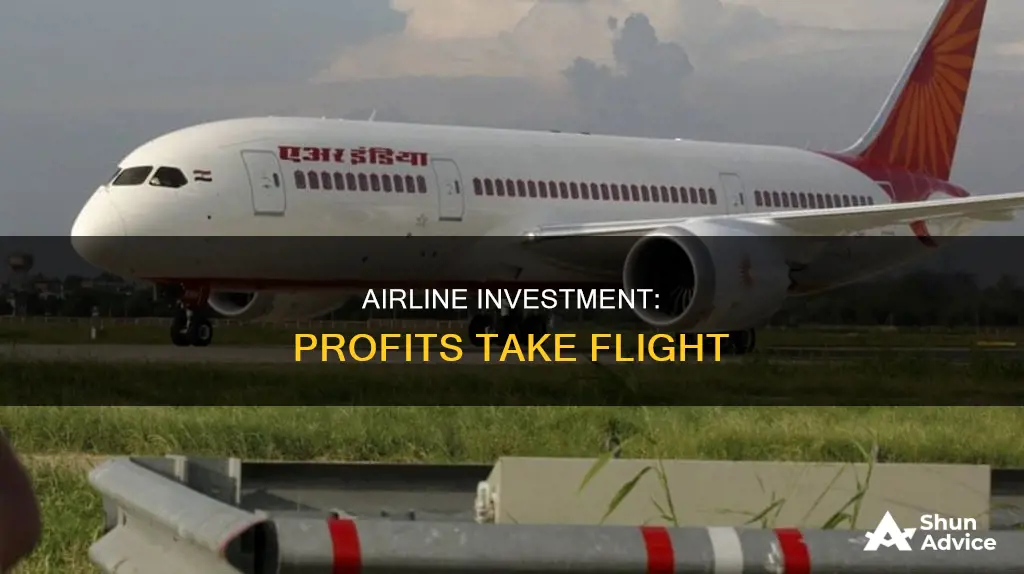
The airline industry is a fascinating yet challenging sector of the economy. It has been described as a terrible investment and a black hole for investors, with high operating costs, heavy competition, and a history of bankruptcies. However, the industry is essential, and some investors are attracted by the potential for high rewards.
The COVID-19 pandemic caused a crisis for airlines, with revenues and share prices plummeting. However, the industry has proven its resilience, and some airlines have emerged stronger, with government aid and less competition. As travel demand returns, airlines are well-positioned to benefit from new work patterns and sustained leisure travel.
Despite the risks, some investors are attracted to the potential for high rewards in the airline industry. With careful analysis of metrics such as capacity, passenger volume, revenue per passenger, and costs, it is possible to identify well-run airlines with strong growth potential.
Additionally, the industry has seen consolidation, with a small group of competitors dominating the market and leveraging technology to improve efficiency. This may create opportunities for investors to back successful airlines with strong brand loyalty and efficient operations.
What You'll Learn
- The airline industry is essential to the modern economy
- The industry was profitable before the pandemic
- Airlines are facing a crisis, but this could be an opportunity for investors
- The pandemic has changed travel demand patterns, which could benefit airlines in the long term
- Airlines are capital-intensive and have high operating costs

The airline industry is essential to the modern economy
The airline industry is an essential part of the modern economy, but it is also one of the riskiest sectors to invest in. The industry has been described as a "terrible experience" for investors, with the potential for curveballs and a history of throwing up challenges for investors and promoters alike.
However, the industry is fascinating and has been an important driver of economic growth, particularly in the postwar period. Air passenger traffic has increased exponentially, hitting 4.6 billion passengers in 2019. This growth has been driven by technological advancements and economic booms.
The COVID-19 pandemic caused a significant drop in airline revenues and share prices, with airlines around the world making an estimated $118 billion loss in 2020. However, the industry has proven resilient, and many airlines have managed to weather the storm with government aid.
Additionally, the industry has a significant impact on employment. Airlines create numerous direct and indirect jobs, from pilots and cabin crew to ground staff and maintenance workers. The industry also supports various other sectors, such as aviation manufacturing, airport operations, and tourism.
The airline industry has also been an essential driver of technological innovation. Advancements in aircraft design, navigation systems, and fuel efficiency have improved safety and efficiency, making air travel more accessible and affordable.
Furthermore, the industry has a significant economic impact through its supply chain. Airlines purchase goods and services from various sectors, including fuel, aircraft manufacturing, catering, and technology. This creates a ripple effect, stimulating economic activity and supporting businesses worldwide.
While the airline industry has faced challenges, it has proven its resilience and importance to the global economy. It facilitates trade, connects people, and drives technological advancements. As the world recovers from the pandemic, the industry is well-positioned to continue playing a crucial role in shaping the modern economy.
Black Americans: Investors or Not?
You may want to see also

The industry was profitable before the pandemic
The airline industry was consistently profitable throughout the 2010s, with the decade being the most profitable in its history. However, the COVID-19 pandemic has had a devastating impact on the industry, with airlines haemorrhaging $168 billion in economic losses in 2020 alone.
Before the pandemic, the industry was already facing long-term health problems, with high capital intensity, fluid supply, low entry barriers, and strong negotiating power held by suppliers and passengers. These factors contributed to airlines bleeding $17 billion in economic profit per year from 2012 to 2019.
Despite these challenges, the airline industry was still able to generate healthy profits overall, and the past decade was one of the most profitable in its history. The growth in global air passenger traffic, which hit 4.6 billion passengers in 2019, contributed to this profitability.
The pandemic has, of course, changed this dynamic, with airlines suffering massive losses and struggling to recover. However, it is important to recognise that the industry was, in fact, profitable before the pandemic, and with the right strategies, there is a potential for it to return to profitability in the future.
Seeking Investors for Your Farm?
You may want to see also

Airlines are facing a crisis, but this could be an opportunity for investors
The airline industry is facing a crisis due to the impact of the COVID-19 pandemic, which caused a significant drop in global passenger traffic and revenue. However, this crisis could also present an opportunity for investors as airline stocks are currently selling at bargain prices. While there are risks associated with investing in airlines, there may be potential for gains as the industry recovers.
Impact of the pandemic on the airline industry
The COVID-19 pandemic has had a devastating effect on the airline industry, with airlines worldwide losing an estimated $118 billion in 2020. Global passenger traffic fell drastically, and social distancing measures and travel restrictions led to empty airports and airplanes. The pandemic disrupted normal travel patterns and resulted in cancelled flights and congested airports. The International Air Transport Association predicted that a full recovery for the industry might not occur until 2024.
Challenges and opportunities for investors
Investing in airline stocks during this crisis carries risks. Airlines are capital-intensive businesses with high operating costs, and the pandemic has led to negative cash flow and increased debt for many companies. Additionally, the conflict in Ukraine and rising oil prices have impacted the industry, as fuel accounts for a significant portion of an airline's total costs. These challenges have resulted in a struggle to survive for many airlines, with some requiring government aid to stay afloat.
However, the crisis has also created opportunities for investors. Low-cost airlines may gain market share from higher-cost competitors, and some companies may successfully reduce their fixed costs. Additionally, the shift to remote work and "work from anywhere" has created a more stable demand for leisure travel, smoothing out the traditionally cyclical nature of the industry.
Analyzing airline companies for investment
When considering investing in airline stocks, it is essential to analyze industry-specific metrics and financial performance. Available seat miles (ASM), revenue passenger miles (RPM), load factor, passenger yield, and cost per available seat mile (CASM) are crucial factors in evaluating an airline's capacity, utilization, revenue, and costs. Comparing these metrics between companies and over time can provide insights into their operational efficiency and financial health.
In conclusion, while the airline industry is facing a crisis due to the pandemic and other challenges, this could be an opportunity for investors to enter the market at a lower cost. A careful analysis of key metrics and financial indicators can help identify airlines with strong performance and potential for recovery. However, investing in airlines carries risks, and it is crucial for investors to make informed decisions considering all relevant factors.
Fear of Losing Money: Why People Don't Invest
You may want to see also

The pandemic has changed travel demand patterns, which could benefit airlines in the long term
The COVID-19 pandemic has had a devastating impact on the airline industry, causing massive financial losses and disrupting travel demand patterns. However, as the industry adapts to the new realities of the pandemic, there are several reasons to believe that travel demand patterns will change in ways that could benefit airlines in the long term.
Firstly, leisure travel is expected to fuel the recovery of the airline industry. While business travel will take longer to rebound, leisure trips and visits to friends and relatives tend to be the first to recover after a crisis. Airlines should reevaluate their flight economics, considering different pricing logic and network changes to cater to the increased demand for leisure travel. This may include narrowing the gap between nonstop and connect flight pricing and utilizing larger aircraft for long-haul flights to reduce unit costs.
Secondly, the pandemic has accelerated the adoption of digital technologies in the airline industry. The use of mobile apps to store travel documents and the development of more advanced online platforms will improve the customer experience and increase efficiency. Airlines that invest in IT and digitalization will be better positioned to adapt to the changing demands of travellers and optimize their operations.
Thirdly, the pandemic has highlighted the importance of resilience in the airline industry. Airlines that can bolster their cash reserves, increase agility, and improve their ability to reduce supply quickly in response to sudden demand drops will be better equipped to navigate future crises. Additionally, focusing on reducing complexity, improving efficiency, and collaborating across the travel ecosystem can help airlines enhance their operational performance and reduce bottlenecks.
Finally, the pandemic may have permanently altered business travel behaviour. With remote work and flexible working arrangements becoming more common, people are likely to take fewer corporate trips. This shift could lead to a greater focus on catering to premium-leisure passengers and optimizing cabins to accommodate couples or groups. Airlines that can adapt their offerings to meet the changing needs of business travellers may gain a competitive advantage.
While the airline industry faces significant challenges in the aftermath of the pandemic, the changes in travel demand patterns present opportunities for innovation, efficiency, and improved customer satisfaction. By adapting to these new realities, airlines can position themselves for long-term success and benefit from the recovery of the travel sector.
Germans' View on Chinese Investments
You may want to see also

Airlines are capital-intensive and have high operating costs
Airlines have high fixed costs, including airport fees, pilot salaries, and fuel costs. These costs are often beyond the control of the airline, such as fuel costs being influenced by oil prices. As a result, airlines often operate on very thin margins. Any increase in costs can significantly impact their profitability.
The airline industry is also highly competitive, with low-cost carriers driving down prices and intensifying competition. This competition often leads to a poor experience for customers, as airlines cut costs to remain profitable. Overbooking, flight cancellations, and poor customer service are common issues.
Despite the risks, some investors may view airlines as an attractive investment opportunity, especially during times of crisis when stock prices are low. Consolidation and industry improvements, such as technological advancements and stable labour relations, can also make airlines more appealing to investors.
Overall, while airlines can be capital-intensive and have high operating costs, there are also factors that contribute to their investment potential, such as their essential role in the global economy and the potential for strong profitability during favourable conditions.
Mutual of America: Worth the Investment?
You may want to see also
Frequently asked questions
People invest in airlines because they believe in the potential for high profits in the airline industry. The industry is essential to the modern economy and has been highly profitable in the past.
Airline stocks are often considered a risky investment due to the industry's susceptibility to economic downturns, rising fuel prices, and other factors such as the COVID-19 pandemic, which caused a significant drop in demand for air travel.
The airline industry experienced its most profitable decade in the 2010s. However, the COVID-19 pandemic caused significant losses in 2020, with the industry losing an estimated $118 billion.
Investors should analyze key metrics such as capacity, passenger volume, revenue per passenger, and operating costs. They should also consider the company's financial health, competition, and potential regulatory changes.
Yes, notable investors like Warren Buffett have had success with airline investments. After initially vowing to never invest in airlines again, Buffett invested in the four major U.S. air carriers in 2017 following industry consolidation and improving margins.







